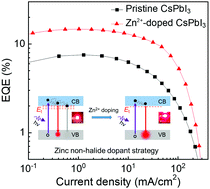A zinc non-halide dopant strategy enables efficient perovskite CsPbI3 quantum dot-based light-emitting diodes†
Abstract
Metal ion doping has been considered as one of the most effective methods to achieve highly efficient perovskite light-emitting diodes (LEDs), which is significant for future high-definition displays and high-quality lighting. However, its exact function is still uncertain because the doping of metal ions is also accompanied by the introduction of halide ions and halide-rich circumstances, which can enhance the optoelectronic properties as well. In this work, a zinc non-halide dopant strategy was employed to specifically study the effect of Zn2+ on CsPbI3 quantum dots (QDs). We confirmed that Zn2+ was doped into the perovskites interstitially via X-ray diffraction (XRD) and pair distribution function (PDF) analysis. Zn2+-doped CsPbI3 QDs exhibited higher emission properties with 120% enhancement in the photoluminescence quantum yield (PLQY) compared with pristine CsPbI3 QDs. The Zn2+-doped CsPbI3 QD-based LEDs (QLEDs) showed nearly two-fold increase in the external quantum efficiency (EQE) versus the control device, and it improved from 7.5% to 14.6%. Besides, a maximum current efficiency of 0.83 cd A−1 and the highest luminance of 378 cd m−2 were achieved. These results certify that Zn2+ doping enables high-performance QLEDs without the introduction of halide ions, which is beneficial for the further research on doped perovskite fields and lays the foundation for the future practical applications of QLEDs.



 Please wait while we load your content...
Please wait while we load your content...